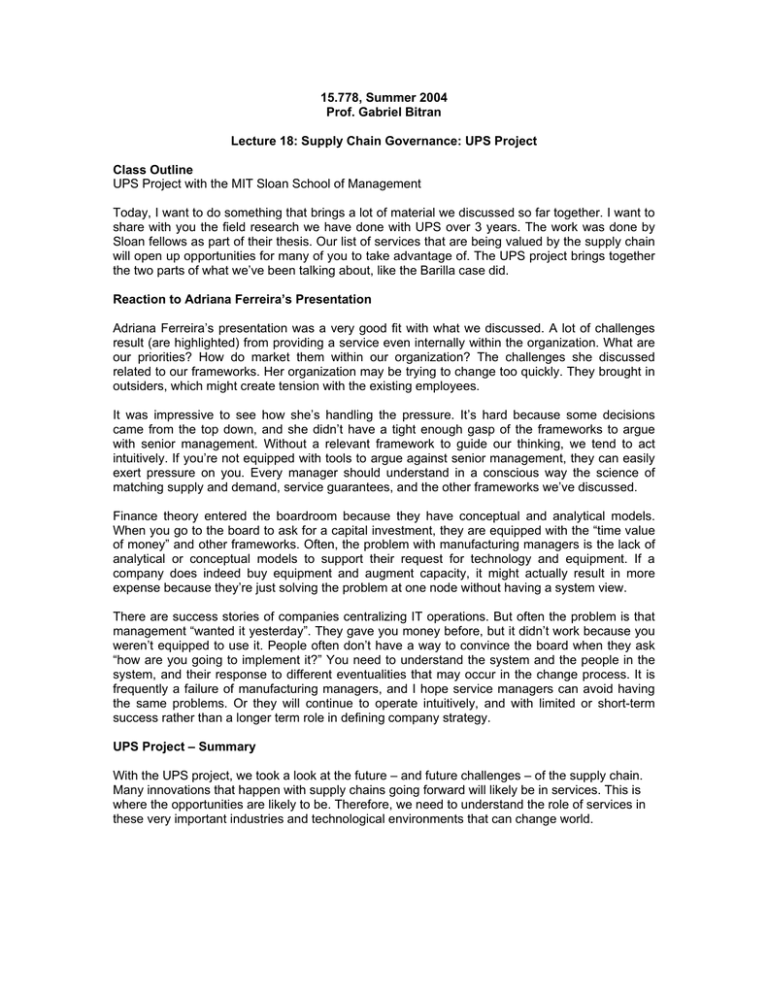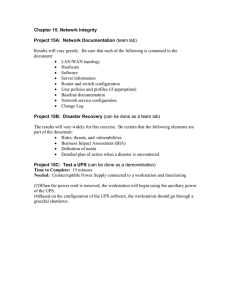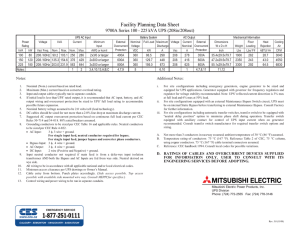15.778, Summer 2004 Prof. Gabriel Bitran Class Outline
advertisement

15.778, Summer 2004 Prof. Gabriel Bitran Lecture 18: Supply Chain Governance: UPS Project Class Outline UPS Project with the MIT Sloan School of Management Today, I want to do something that brings a lot of material we discussed so far together. I want to share with you the field research we have done with UPS over 3 years. The work was done by Sloan fellows as part of their thesis. Our list of services that are being valued by the supply chain will open up opportunities for many of you to take advantage of. The UPS project brings together the two parts of what we’ve been talking about, like the Barilla case did. Reaction to Adriana Ferreira’s Presentation Adriana Ferreira’s presentation was a very good fit with what we discussed. A lot of challenges result (are highlighted) from providing a service even internally within the organization. What are our priorities? How do market them within our organization? The challenges she discussed related to our frameworks. Her organization may be trying to change too quickly. They brought in outsiders, which might create tension with the existing employees. It was impressive to see how she’s handling the pressure. It’s hard because some decisions came from the top down, and she didn’t have a tight enough gasp of the frameworks to argue with senior management. Without a relevant framework to guide our thinking, we tend to act intuitively. If you’re not equipped with tools to argue against senior management, they can easily exert pressure on you. Every manager should understand in a conscious way the science of matching supply and demand, service guarantees, and the other frameworks we’ve discussed. Finance theory entered the boardroom because they have conceptual and analytical models. When you go to the board to ask for a capital investment, they are equipped with the “time value of money” and other frameworks. Often, the problem with manufacturing managers is the lack of analytical or conceptual models to support their request for technology and equipment. If a company does indeed buy equipment and augment capacity, it might actually result in more expense because they’re just solving the problem at one node without having a system view. There are success stories of companies centralizing IT operations. But often the problem is that management “wanted it yesterday”. They gave you money before, but it didn’t work because you weren’t equipped to use it. People often don’t have a way to convince the board when they ask “how are you going to implement it?” You need to understand the system and the people in the system, and their response to different eventualities that may occur in the change process. It is frequently a failure of manufacturing managers, and I hope service managers can avoid having the same problems. Or they will continue to operate intuitively, and with limited or short-term success rather than a longer term role in defining company strategy. UPS Project – Summary With the UPS project, we took a look at the future – and future challenges – of the supply chain. Many innovations that happen with supply chains going forward will likely be in services. This is where the opportunities are likely to be. Therefore, we need to understand the role of services in these very important industries and technological environments that can change world.




